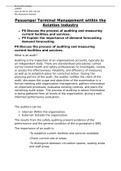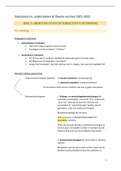1. Definition of: Fiscal policy, deficit budget, surplus budget and a balanced budget
● Fiscal Policy: macroeconomic policy that can influence resource allocation, redistribute
income and reduce the fluctuations of the business cycle. Its instruments include
government spending and taxation and the budget income
● Deficit Budget: occurs when government expenditure exceeds government revenue
● Surplus Budget: occurs when government revenue exceeds government expenditure
● Balanced Budget: when government revenue equals government expenditure
2. The objectives of fiscal policy (in general as a macro economic management tool)
● Plays a supporting role in maintaining low inflation; fiscal policy settings that support low-
inflation objective may also reduce need for higher interest rates to combat inflation
● Expansionary fiscal policy may reduce taxation revenue or government expenditure
(both) - creates small surplus or bigger deficit and aims to increase level of economic
activity by stimulating aggregate demand
● Contractionary fiscal policy occurs through government planning to increase taxation or
decrease spending (both). Decrease level of economic activity by dampening aggregate
demand
● Contractionary fiscal policy through increased revenue and decreased spending reduces
demand pressure in economy and reduces demand-pull inflation
○ Eg. plan to reduce budget deficit over the medium-term reflects a strategy of
reducing inflationary pressure and taking pressure off rising interest rates
○ Eg. fiscal settings between late late 2007-2010 were opposite - substantial
increase in government spending to stimulate economy during downturn
● Fiscal policy has substantial impact on external stability
○ By accumulating budget surpluses (through fiscal consolidation), FP can help
raise public savings and thus retire public debt, which helps reduce NFD and
thus CAD
○ Reducing the deficit can reduce upward pressure on IR and also lessen the
‘crowding out’ effect of private borrowers
3. The structural and cyclical components of the Budget
● Government budget aggregates reflect the net impact of structural components and
cyclical components of the budget
● The structural component of the budget refers to explicit changes in government
spending or taxation policies, whilst the cyclical component of the budget refers to
changes in government spending and/or revenue which are caused by changes in the
level of economic activity according to the business cycle
● The structural component refers to the fiscal position that is generated under ‘normal’
economic conditions, usually interpreted as a situation in which the economy is operating
at its maximum feasible non-inflationary output level given existing technology and
production capacity known as the economy’s potential level of output
● When the actual level of output varies from potential there will be a cyclical component to
the budget balance. The magnitude of this cyclical component will depend on the size of
, the deviation of the economy from potential and the responsiveness of expenditures and
revenues to this deviation
○ Estimating the cyclical component of the fiscal position therefore requires
quantification of the size of the deviation of actual output from potential and the
cyclical sensitivity of the budget aggregates. The result of this estimation is then
subtracted from the actual budget balance to obtain the structural balance
measure. A key input into this estimation is the calculated output gap, which is
the difference between the actual level of output and the economy’s potential
level of output.
● Automatic Stabilisers (also Non Discretionary): Policy instruments in govt budget that
counterbalance economic activity (countercyclical role)
○ They are built into the Budget and activated by change in level of eco activity, not
by a deliberate change in govt policy (ie they are cyclical/non discretionary
component)
○ On their own, they aren’t powerful enough to bring economy out of severe
recession or to curb economic boom -> merely reduce severity
○ Unemployment benefits: Welfare payments or social security
■ recession-> output/income fall -> unemployment rises. Jobless register
increases “automatically” -> increase disposable income -> consumption
for these individuals does not fall to 0 -> reduction in AD is smaller ->
less fluctuation
○ Progressive Taxation: People on high income increase -> increase tax (bracket
creep) -> limits increase in disposable income -> softens fluctuations
4. The change in Budget outcomes over the economic cycle (upswing, boom, downturn, recession)
● Government expenditures and revenues vary with the economic cycle
● When output growth is running above trend, expenditure falls and revenue rises, relative
to trend
● Expenditure falls when growth is higher there is less spending on unemployment benefits
and other welfare programmes, while tax revenue rises through higher company profits,
wages and consumer spending
● When output growth is below trend, the converse applies. The Government’s fiscal
strategy, which aims for balance over the cycle, abstracts from such cyclical movements
● The effect of contractionary fiscal policy is to reduce the total level of economic activity
and would be used to reduce spending, growth and inflationary expectations, if the
economy was experiencing excessive inflation in a boom cycle











